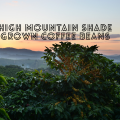By Jed Vaughn
Everyone appreciates waking up to a great cup of coffee! There’s nothing better in the morning than that heady aroma of freshly ground and brewed coffee beans. I love to grind them just before brewing. It wakes you right up!
My favorite choice of wake-up when I’m in Mazatlán, Mexico, is the shade-grown Artisanal Coffee from the Chiapas Highlands. Located in the Southern Pacific region by the Guatemalan border, the beans come from small organic farms around the region. I buy the fresh beans from a local coffee shop in Mazatlan’s Centro Historic District.
Chiapas coffee is a universal favorite with locals and tourists alike. Typically it’s a dark, stronger blend. The different batches of beans can vary in quality, but for the average coffee drinker, it’s not discernible. But, for the coffee connoisseur, subtle differences can be detected.
The coffee grown in Mexico is 80% Arabica and 20% Robusta. One of the differences between the two beans is that Arabica is self-pollinated and Robusta is cross-pollinated.
As the name indicates, Robusta coffee beans are also more robust than the Arabica plants. The Robusta beans produce an inferior tasting beverage but a higher caffeine content.
Coffee was introduced in the Chiapas region at the end of the 19th century. Today it’s an important coffee cultivation region in Mexico. According to Visit Mexico, the famous coffee route leads tourists to the mountainous areas to the haciendas. Bird watching, mountain biking, horseback riding, camping, rafting and of course, visiting coffee plantations are popular sought after activities in Chiapas.
One of the most popular plantations is Argovia. Built in the 1880s, it now offers cabins, suites, and a restaurant serving European and Mexican cuisine. For those who enjoy adventure tourism and gourmet coffee, Visit Mexico recommends Chiripa at San Bias, Nayarit. For history and health buffs, head over to Finca Hamburgo Café in Tapachula. Finca Hamburgo offers rustic wooden cabins, spa services, panoramic views, and plenty of activities including hiking. This plantation has its own coffee museum and gift shop.
One of my favorite things about buying coffee in Mexico is the super-low price. I typically pay 100 pesos for a half kilo, about 1lb, which at the current exchange rate in USD is about $5.50. This is about half of what it is in the U.S.
Preparation methods have a big effect on the cup of java you’re drinking but regardless of the preparation method used, I like knowing exactly where the beans come from. The fact it hasn’t been warehoused for lengthy periods of time is something that I appreciate greatly.
Have you tried Chiapas coffee or have you visited any of the coffee plantations in Chiapas? Let us know.
